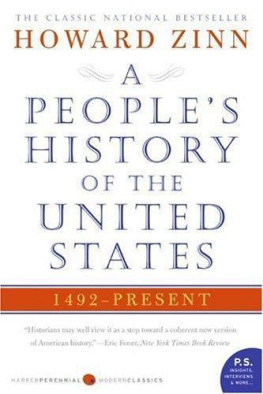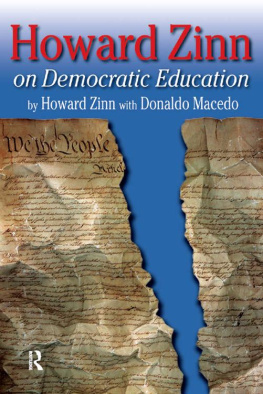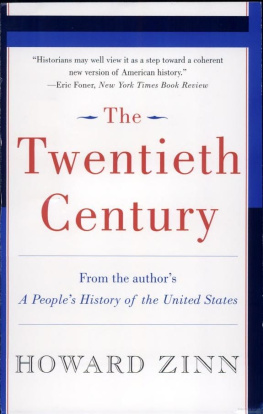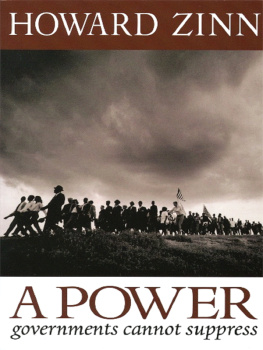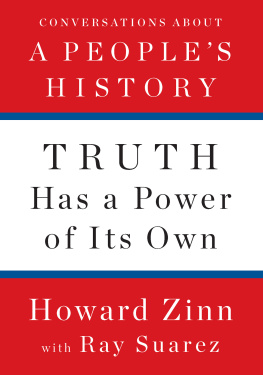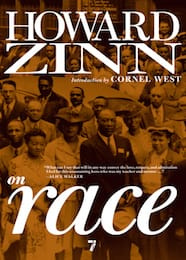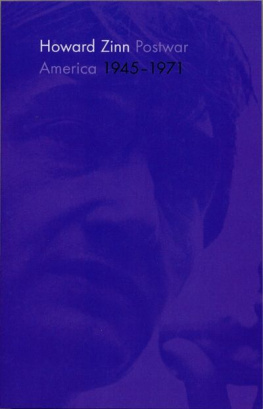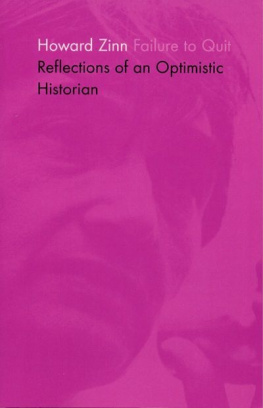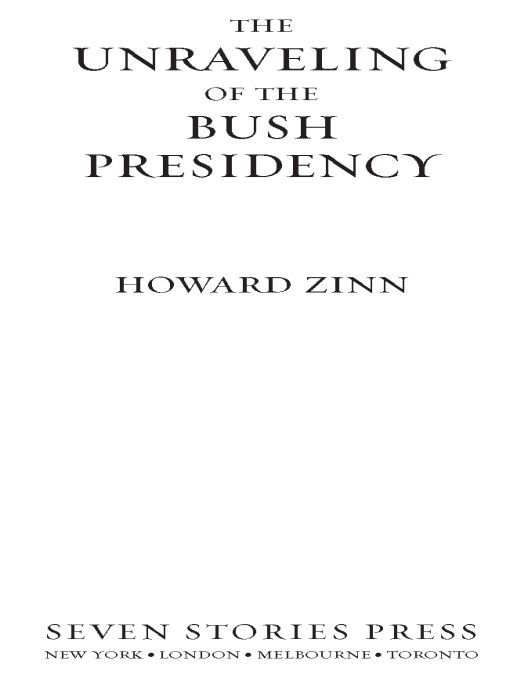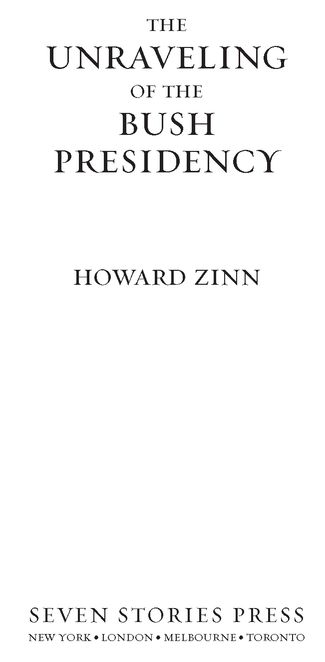Table of Contents
The last edition of A Peoples History of the United States ends with the election of 2000. In that election, the Democratic candidate, Al Gore, received hundreds of thousands of votes more than George Bush, but in the State of Florida, whose governor was George Bushs brother, the official in charge of counting votes was a leading Republican, and she declared Bush the winner by a tiny margin. She refused to have a recount though thousands of votes were not counted, especially in districts of black voters. The Florida Supreme Court overruled her, ordering a full recount, but the Supreme Court of the United States, by a five to four vote (all five being Republican appointees) refused a recount, leaving Bush the winner.
My Peoples History also ends with the tragedy of September 11, 2001, when hijackers crashed their planes into the World Trade Center in New York, killing close to three thousand people. Bush immediately declared a war on terrorism and proclaimed, We shall make no distinction between terrorists and countries that harbor terrorism. The Senate and the House of Representatives approved a resolution giving Bush the power to take military action, with only one member of Congress, an African-American representative from California, Barbara Lee, refusing to give her consent.
On the supposition that the hijackings had been ordered by the militant Islamic group Al Qaeda, whose leader was Osama Bin Laden, United States forces bombed and invaded Afghanistan. Bin Laden was never captured, and the Al Qaeda organization remained alive, but in the military operation thousands of Afghan civilians were killed, and hundreds of thousands forced from their homes.
The terrible toll of human life in the invasion was justified on the ground that it removed the Taliban, a fundamentalist Islamic group that ruled Afghanistan with an iron hand, and was responsible for countless atrocious acts against the population. However, the defeat of the Taliban brought into power the Northern Alliance, which had been responsible in the mid-90s for many acts of violence against the people of Kabul and other Afghan cities.
George Bush, in his 2002 State of the Union Address, claimed that with the ouster of the Taliban, Today women are free. But this was a false claim, according to an organization of Afghan women. The New York Times reporter, Nicholas Kristoff, two years after the invasion, reported that Afghan women were not free. Although he had supported the U.S. attack on Afghanistan, he now felt betrayed, as do the Afghans themselves. He found that banditry and chaos are rampant, longtime warlords control much of the country, the Taliban is having a resurgence in the southeast and he quoted a U.N. report worrying that Afghanistan would soon be in the hands of drug cartels and narco-terrorists.
Sixteen months into the war, a Scotsman who took medical aid to thirteen Afghan villages was distressed at what he saw: The country is on its knees.... It is one of the most heavily land-mined countries in the world... 25% of all children are dead by the age of five. He concluded, sadly: Surely, at the start of our 21st century, we should have evolved beyond the point where we reduce a country and a people to dust, for the flimsiest of excuses.
As late as August of 2006, air strikes were still killing Afghan civilians, and the New York Times reported corruption, violence and poverty were widespread in the country.
It was clear that the military attack on Afghanistan had neither brought democracy or security, or weakened terrorism. In fact, in his State of the Union address in January 2002, President Bush, while claiming that we are winning the war on terror, admitted that tens of thousands of trained terrorists are still at large. Indeed, if anything, the violence unleashed by the United States, angering people in the Middle East, had increased the number of terrorists.
With Afghanistan still in turmoil, the Bush administration began to set the stage for a war against Iraq. Richard Clarke, adviser to the president on matters of terrorism, reported later that immediately after the attacks of 9-11, the White House was looking for reasons to attack Iraq, though there was no evidence linking Iraq to those attacks.
Starting in 2002, George Bush and the officials closest to him, Vice President Dick Cheney, Secretary of Defense Donald Rumsfeld, and National Security Advisor Condoleeza Rice, began a campaign to persuade the public that Iraq and its dictator, Saddam Hussein, constituted a serious threat to the United States and to the world. They accused Iraq of concealing weapons of mass destruction, including plans to build a nuclear weapon.
A United Nations inspection team, making hundreds of inspections all over Iraq, was unable to find these weapons. There was no evidence of Iraq working on a nuclear weapon, but Vice President Cheney insisted it was a fact, and Condoleeza Rice spoke menacingly of a mushroom cloud, invoking the picture of the atomic bombing of Hiroshima. A climate of hysteria was created. The government pointed to atrocities committed by Saddam Hussein, including the massacre of 5,000 Iraqi Kurds by the use of chemical poisons. In fact, Hussein was a monstrous tyrant, but when the killing of the Kurds took place in 1988 the United States raised no strenuous objections. It saw Iraq as an ally, and supported its war against Iran.
What was the real reason for the build-up of a war atmosphere against Iraq? It was not credible that Iraq, a country ruined by two wars (In the 1980s against Iran, in 1991 the invasion by the United States) and devastated by ten years of economic sanctions, was a threat to the greatest military power on earth.
Much more likely as a reason for war was that Iraq possessed the second largest oil reserves in the world (Saudi Arabia was first), and the United States, ever since the end of World War II, was determined to control the oil of the Middle East. That motive was behind the U.S. actions when, in 1953, it overthrew a government in Iran which nationalized its oil industry. The result of the coup was to restore to power the dictatorship of the Shah. Oil continued to govern U.S. policy in the region whether Democrats or Republicans were in the White House. Indeed, it was in the administration of the liberal Democrat Jimmy Carter that the Carter Doctrine was enunciated, declaring that the United States would defend its interest in Middle East oil by any means necessary, including military force.
None of this, however, was told to the public. It was part of a historic pattern in U.S. foreign policy to tell the American people that war was necessary to defend the United States against a threat, or to bring liberty and democracy to other countries, while the real motives for warthe profits of corporations, the control of vital raw materials, the expansion of the U.S. empirewere concealed.
The Bush administration hoped to get the United Nations to support a war against Iraq, but the other members of the Security Council were not convinced, even though Secretary of State Colin Powell gave a speech to the U.N.later exposed as false informationlisting the weapons of mass destruction he claimed were possessed by Saddam Hussein.
In a document called National Security Strategy issued in September 2002, the Bush administration had declared its determination to take military action unilaterally, that is, without international support, whenever it felt this necessary to maintain its supremacy in the world. This was a violation of the Charter of the United Nations, which allowed military action only in self-defense, and only when approved by the Security Council.


